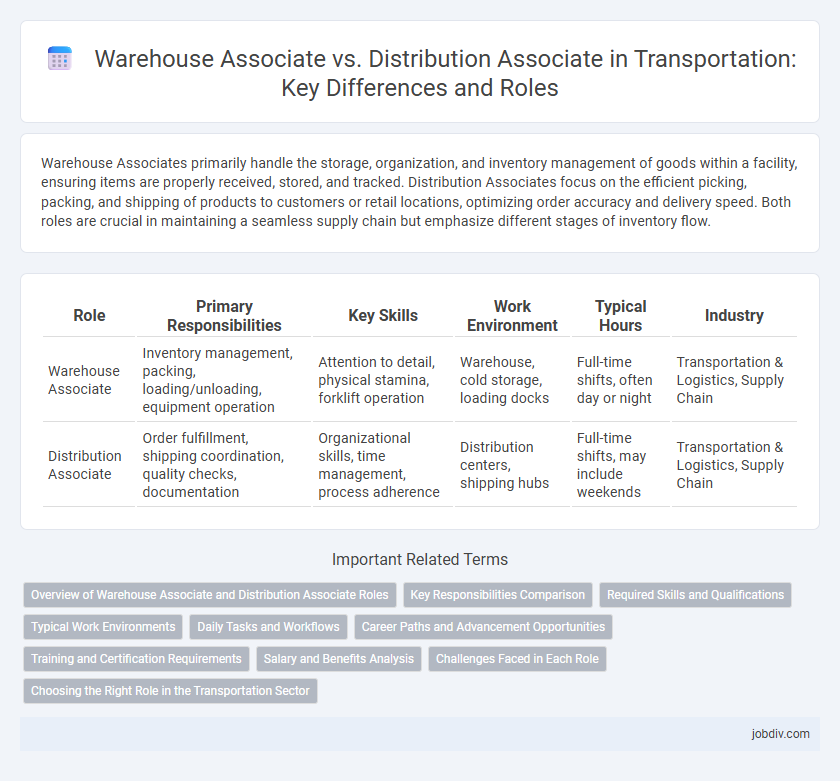Warehouse Associates primarily handle the storage, organization, and inventory management of goods within a facility, ensuring items are properly received, stored, and tracked. Distribution Associates focus on the efficient picking, packing, and shipping of products to customers or retail locations, optimizing order accuracy and delivery speed. Both roles are crucial in maintaining a seamless supply chain but emphasize different stages of inventory flow.
Table of Comparison
| Role | Primary Responsibilities | Key Skills | Work Environment | Typical Hours | Industry |
|---|---|---|---|---|---|
| Warehouse Associate | Inventory management, packing, loading/unloading, equipment operation | Attention to detail, physical stamina, forklift operation | Warehouse, cold storage, loading docks | Full-time shifts, often day or night | Transportation & Logistics, Supply Chain |
| Distribution Associate | Order fulfillment, shipping coordination, quality checks, documentation | Organizational skills, time management, process adherence | Distribution centers, shipping hubs | Full-time shifts, may include weekends | Transportation & Logistics, Supply Chain |
Overview of Warehouse Associate and Distribution Associate Roles
Warehouse Associates manage inventory storage, organize stock, and prepare goods for shipment within warehouse facilities. Distribution Associates coordinate the sorting, packing, and dispatching of products, ensuring timely delivery to customers or retail locations. Both roles require strong attention to detail, physical stamina, and familiarity with warehouse management systems for efficient supply chain operations.
Key Responsibilities Comparison
Warehouse Associates primarily manage inventory control, including receiving, storing, and organizing goods within the warehouse to ensure efficient stock levels and accurate record-keeping. Distribution Associates focus on order fulfillment, packaging, and coordinating shipments to meet delivery deadlines and optimize supply chain flow. Both roles require proficiency in operating material handling equipment and adherence to safety protocols, but Distribution Associates typically engage more with logistics and carrier communications.
Required Skills and Qualifications
Warehouse Associates require proficiency in inventory management, forklift operation, and adherence to safety protocols, often needing a high school diploma and prior warehouse experience. Distribution Associates must possess strong organizational skills, experience in order fulfillment processes, and knowledge of shipping regulations, typically requiring certifications in logistics or supply chain management. Both roles demand physical stamina, attention to detail, and the ability to operate warehouse management systems efficiently.
Typical Work Environments
Warehouse Associates typically work in storage facilities, managing inventory, packing, and loading goods onto trucks in climate-controlled or large-scale warehouses. Distribution Associates operate in distribution centers where the emphasis is on sorting, processing, and shipping products efficiently to various retail outlets or customers. Both roles demand familiarity with material handling equipment and adherence to safety protocols in fast-paced environments.
Daily Tasks and Workflows
Warehouse Associates primarily manage inventory by receiving, storing, and organizing goods, ensuring accurate stock levels through regular audits. Distribution Associates focus on order fulfillment, picking, packing, and preparing shipments efficiently to meet delivery deadlines. Both roles require coordination with logistics teams, but Warehouse Associates emphasize inventory control while Distribution Associates prioritize outbound distribution workflows.
Career Paths and Advancement Opportunities
Warehouse Associates typically focus on inventory management, order fulfillment, and maintaining storage areas, providing foundational skills valuable for advancing into supervisory roles within warehousing operations. Distribution Associates often handle logistics coordination, shipment scheduling, and quality control, positioning themselves for career progression into supply chain management and logistics planning roles. Both career paths offer opportunities for specialization and leadership, with advancement potential influenced by experience, certifications like forklift operation or logistics management, and proficiency in warehouse management systems (WMS).
Training and Certification Requirements
Warehouse Associates typically require basic safety training and forklift certification to handle inventory and equipment efficiently within storage facilities. Distribution Associates often need more specialized training in logistics software, order processing systems, and may require certifications like OSHA compliance and hazardous materials handling. Both roles emphasize hands-on experience, but Distribution Associates generally require advanced knowledge of supply chain protocols and regulatory standards.
Salary and Benefits Analysis
Warehouse Associates typically earn an average hourly wage of $15 to $18, with benefits including health insurance, paid time off, and retirement plans. Distribution Associates often receive slightly higher compensation, ranging from $16 to $20 per hour, reflecting the increased responsibilities in order fulfillment and logistics management. Benefits for Distribution Associates may also include performance bonuses, shift differentials, and enhanced career advancement opportunities.
Challenges Faced in Each Role
Warehouse Associates often face challenges such as managing inventory accuracy and handling physical strain from heavy lifting and repetitive motions. Distribution Associates encounter difficulties in coordinating timely shipments and ensuring proper sorting to avoid delays in the supply chain. Both roles require maintaining efficiency under time pressure while adapting to technological systems and safety protocols.
Choosing the Right Role in the Transportation Sector
Warehouse Associates specialize in inventory management, goods storage, and order fulfillment within a static facility environment, making them ideal for candidates seeking consistent, detail-oriented roles. Distribution Associates focus on logistics coordination, shipment processing, and route preparation, suitable for individuals who thrive in dynamic, fast-paced settings with a focus on supply chain flow. Selecting the right role depends on prioritizing either operational stability and inventory accuracy or rapid movement and logistical efficiency within the transportation sector.
Warehouse Associate vs Distribution Associate Infographic

 jobdiv.com
jobdiv.com